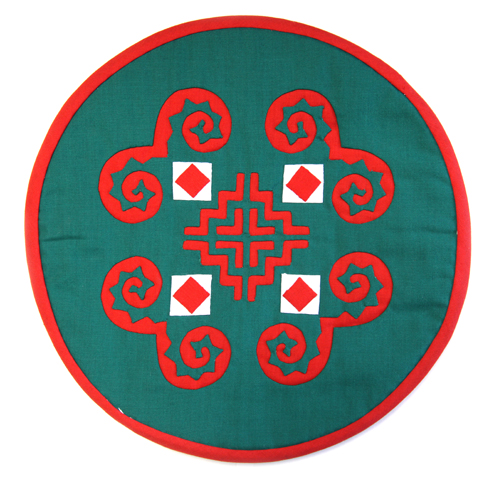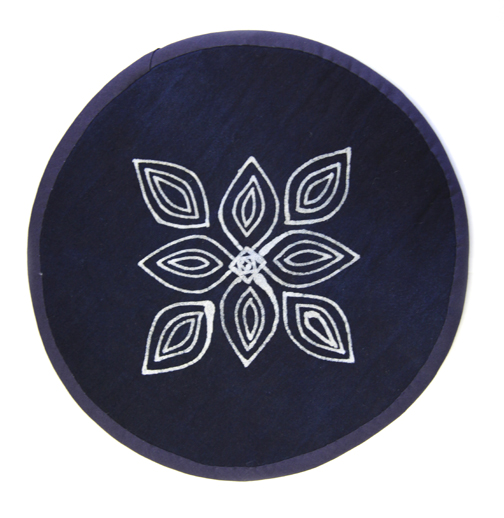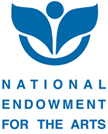Inspired Designs |
|---|
Back to Top |
 |
I11: This fabric is machine-made, and a representation of Hmong embroidery sold commercially to Hmong by non-Hmong. The main motif pictured involves a butterfly. This is not a common motif found in the embroidery work of the Hmong from Laos and Thailand, but it is a popular motif among the Hmong in China, especially those from Guizhou Province where they have a story about a mystical figure named Mother Butterfly. She was born in an old Guam tree, and made love with water bubbles. She gave birth to 12 eggs. It took 12 years for the eggs to hatch. One of the eggs hatched to become Jiang Yang, a Hmong boy. The other eggs hatched to become zodiac signs and spirits. In Hmong mythology, when the people in the heavens come down to the physical world (earth), they typically come in the form of a white butterfly or moth.
Machine-made, 2007, 39x11 cm |
Back to Top |
I12: This bookmark was made in the United States. The embroidery was hand sewn with cross-stitches on a white monk’s cloth, then sewn onto a red ribbon. The motif is the mountain design. Such bookmarks have become quick and inexpensive items to sew for sale at art fairs and other events.
By an unknown artist, 2000s, 13.5x5 cm |
Back to Top |
I13: This is a paj ntaub done on a coarse, enlarged monk’s cloth, or cross-stitch fabric, with each thread much larger than the normal monk’s cloth. It could be thought of as an embroidered baby’s blanket. Large threads were used to embroider the cross-stitch snails, stars, and text. Ka (aka Yvonne) Yang is the woman who made this paj ntaub in 2008. On the top, she embroidered “Hmong Coutume” which could be Hmong Costume, or Hmong Culture, or Hmong Custom. Paj ntaub, like all art forms, can be enjoyed for its beauty, color, composition, and unanswered questions.
|
Back to Top |
 |
I14: The motifs for this hotpad are done in reverse appliqué technique. They are snails
Sold by Camacrafts, Thailand, 1987, 23 cm in diameter |
Back to Top |
I15: This item was made as a coaster for cups and glasses. It is done in appliqué work, and in three colors: red, white, and blue. The motifs of mountains and vertical/horizontal bars are
By an unknown artist, 1985, 9 cm in diameter |
Back to Top |
I16: The green and red complement each other in this Christmas stocking, inspired by the Hmong snail motif, and decorated with seed and flower embroidery. Green and red are colors the Hmong often use in paj ntaub and attire, and are also the colors of Christmas in the Western world.
Sold by Cha Mee, 1989, 24x10 cm |
Back to Top |
 |
I17: This piece functions as a Christmas stocking. The colors utilized include red and green. These are the colors of Christmas, and also popular colors found in Hmong embroidery. The motifs shown on this stocking include the snail and chicken eye. The snails were done in
By Mai Cha, 1988, 30x15 cm |
Back to Top |
 |
I18: This batik piece was made as a hotpad for Camacrafts in Vientiane, Laos, to be sold to tourists. The design involves a combination of several motifs, including hearts. However, when the four motifs face each other, they create an elephant’s foot design. Inside each heart, a center diamond is used as an embellishment. Camacrafts has promoted Hmong paj ntaub and other ethnic crafts in Laos for more than three decades.
Sold by Camacrafts, Laos, 2012, 20 cm in diameter |
Back to Top |
 |
I19: This hotpad is done in batik style using two colors: white and indigo. Those colors are typical of most Hmong batik. On the hotpad, the cucumber seed motif is used for embellishment, but assembled as a water lily.
Sold by Camacrafts, Laos, 2012, 20 cm in diameter |
Back to Top |
 |
I20: This is a batik hotpad. The motif is rather unusual, and not typically found in Hmong
Sold by Camacrafts, Laos, 2012, 20 cm in diameter |
Back to Top |
Page 1 << Page 2 >> Page 3 |



